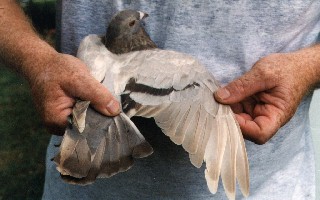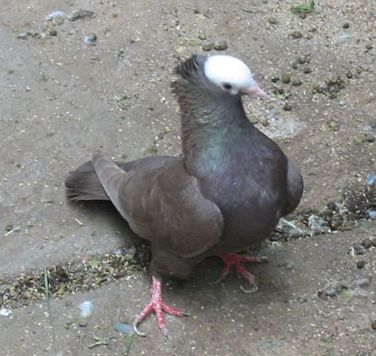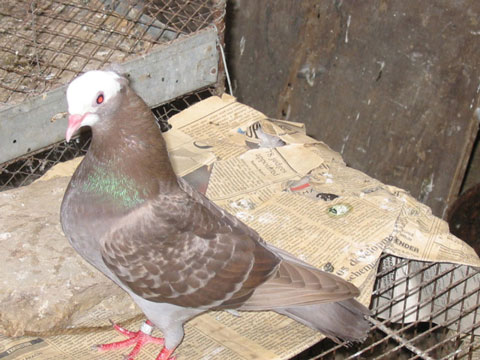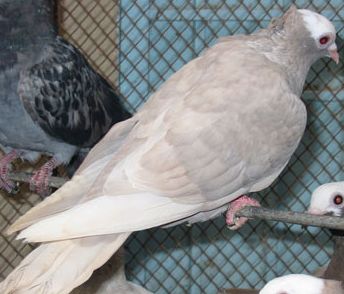Brown in Pigeons
by Frank Mosca

Brown bar mookee from
India.
Brown is one of the three basic pigments known in
pigeons. The other two are red and black. Notice I'm talking about pigment
here and not color. Pigment is the source of color. For example, black pigment
clumped together provides the blue color of pigeons -- as in the blue bar's
wing shield. When this same black pigment is spread out, it absorbs more light
and we see the black wing and tail bars of that same blue barred bird. This is
why even though there is no such thing as a "blue" pigment in pigeons, we
often list the wild-type pigment as blue/black. It's a mnemonic device to
remind us that the same pigment causes what appears to us to be two totally
different colors. The same thing happens with brown. Clumped brown
pigment gives us a "silvery" color like the wing shield of the barred bird
above. Spread brown pigment gives us a dark cocoa colored bird like
those below. All three pigments, brown, black, and red are chemically
different forms of melanin, but for now these differences are of no concern to
us. Here we'll only be discussing brown and its
inheritance.
Since brown pigment is an
intense coloration, it also has its dilute - khaki. Brown and
ash-red are alleles of each other and are sex-linked. Alleles are
alternatives that may be found at the same spot of the chromosome.
Because they are sex-linked, that also means they are on the sex chromosomes
of the bird. Because of this, a wild-type (blue/black) cock as well as
an Ash-red cock may carry brown. However, no Ash-red or wild-type hen
can. Ash-red is dominant to the wild-type condition (blue/black) while
brown is recessive to the wild-type
condition. Since
alleles are given the same genetic base symbol and since ash-red was
discovered to be an allele of brown after brown, which is symbolized as
b, was already described, ash-red is symbolized as
BA. As always, the wild-type pigmentation (blue/black)
is symbolized +.
Brown is not as common in pigeons as is
ash-red and for many years it was confused with the dilute
colors of blue (true silver) and black (dun).
In many cases, it still is and not without reason. Many times the colorations
can be confusingly similar. Brown, however, can usually be distinguished by at
least two signs. Almost invariably, browns show a false pearl eye as
part of their phenotype rather than the orange-red wild type eye. Also, even
intense brown feathers are much more prone to bleaching in the sun than are either
ash-red or blue/black pigmented feathers.
 Photo of brown bar gleefully
swiped from Ron Huntley
Photo of brown bar gleefully
swiped from Ron Huntley
If you look at the spread wing on the photo above
and expand it a bit or go to Ron's page and see the original, you should be
able to see the extreme bleaching of the 8th, 9th, and 10th flights where they
weren't covered by the other feathers.
A classic example of brown, at least in N. America,
is the Silver King, both the utility and show types. Despite their name,
Silver Kings are actually brown birds. Browns are found in all the normal
pigeon patterns. Thus, there are brown barless, brown bars and brown checkers.
All of these can also be found with Spread which produce the Self Brown
coloration. I happen to like this color which reminds me of a rich cocoa.


(L) Brown spread mookees
from India.
(R) Brown check mookee from
India. Browns also have false pearl eye. Genetically they may be of any eye
color, but the false pearl is what shows. The "pink" eyes is a result of
camera flash on the false pearl and an artifact of the photo. All mookees are monk-marked, a minor
selection of Baldhead (Bh). All mookee photos are courtesy of Hisham,
breeder and owner.

(R) Brown homozygous milky
mookee from India
Brown birds can also carry all the other modifiers
found in pigeons. Thus, one can have a brown pigeon which carries Indigo - though it's not a particularly attractive shade when it does.
One can have a milky brown. One can have a brown
Almond; a brown bar ice
(absolutely gorgeous as far as I'm concerned); brown reduced; brown with Toy
Stencil; brown masked by recessive red. etc. As always, one can also have a
very complex combination also, e.g., a brown dilute Dominant Opal Indigo
Checker cock heterozygous for recessive red, reduced, gimple bronze, and bar
-- though, quite honestly, I don't want to be the one to put that bird
together.
Because brown is at the bottom of the
inheritance pile for pigments a mating of a brown cock to any other pigmented
hen is a sex-linked
mating which produces all brown young hens and all
young cocks which will be the color (pigment) of the hen and heterozygous for
brown. A mating of a brown hen to any other homozygous pigmented cock is not
sex-linked and will produce all youngsters the color of the sire with young
cocks heterozygous for brown. A mating of brown cock to brown hen (pattern
immaterial) will produce all brown young of both sexes. If the cock in that
mating happened to also be heterozygous for dilution, then you could get some
khaki (dilute brown hens) also.
Brown is found in many breeds. though as I said
sometimes under other names. I've seen brown Nuns, brown Barbs, brown
Norwich Croppers, brown Racing Homers, brown Runts and Rumblers; brown Monks,
brown Mookees and brown Fantails, both Indian and Standards, brown Kings,
brown Oriental Frills, brown Birmingham Rollers, brown West of England
Tumblers, and brown Modenas, where it is called russet, ochre, silver-cream,
etc. There are also more breeds where brown is
found.
No matter what it's termed in its particular breed
milieu, brown is extremely attractive and adds much to the variety and beauty
of the domestic pigeon.
ADDENDUM: 10/2006 There is some evidence now available: "Biosynthesis of Eumelanin and Phaeomelanin" by Richard Cryberg, that Ash-red and Brown may not be alleles, but just closely linked. This is still being worked on now and would be an exciting finding if true. The link is to the article at Robert Mangile's site - another excellent place to check out.
Some
Brown pics
Some
more Brown pics
Copyright 1999 by Frank Mosca. Revised 2005. This work
may be downloaded or copied for non-commercial individual use only. All other
rights under copyright are retained by the author.
 BACK TO
INDEX
BACK TO
INDEX



